|
RESULTS AND DISCUSSIONS
1. Monthly variations of dissolved oxygen (DO) concentrations
Water quality parameters were monitored on monthly basis [Table-1]. Significant variations in mean monthly values of DO were observed [Figure-2]. DO ranged from 0 to 5 mg/l depending on the extent and density of macrophytes during the morning.
Table: 1. Physico-chemical parameters of Varthur lake
| Parameters |
Units |
µ |
σ |
Min |
Max |
| Nitrates |
ppm |
0.304 |
0.219 |
0.1 |
0.96 |
| Ammonium |
ppm |
15.06 |
7.6 |
3.93 |
30.73 |
| Phosphates |
ppm |
0.98 |
0.7 |
0.14 |
3.5 |
| Total Phosphates |
ppm |
7.86 |
2.44 |
3.14 |
9.87 |
| BOD |
ppm |
89.65 |
38.54 |
44 |
186.1 |
| COD |
ppm |
98.2 |
21.24 |
52 |
197.3 |
| pH |
units |
7.61 |
0.64 |
6.2 |
8.22 |
| EC |
µS/cm |
1054.4 |
158.64 |
751 |
1420 |
| DO |
ppm |
1.56 |
0.67 |
0 |
13 |
| Transparency |
cm |
23 |
3.16 |
18 |
28 |
| Turbidity |
NTU |
78.5 |
25.6 |
29 |
224 |
| ORP |
mV |
-9.33 |
129.29 |
-235 |
135 |
Note: µ: mean; σ: standard deviation; Min: minimum, Max: maximum

Figure: 2. Month-wise variations in Dissolved Oxygen
In anthropogenically modified, weed-infested streams from upper reaches, deoxygenated water (DO = 0–0.3 ppm) arrives for most part of the day, due to high flow rates of water through extensive weed mats. The influx of hypoxic, nutrient rich wastewaters during the mid day is more stressful to aquatic biota as fish and invertebrates that undergo higher metabolic rates during the day require a higher DO than in the night.
According to BIS (IS 10500-1991) and CPCB standards, the oxygen saturation for surface waters should be around 75% (6 ppm), yet it is the minimum that decides the aptness of habitat for various species (rather than average-based guidelines). Most of the DO data for urban Indian lakes are spot one time measurements during daylight hours, when DO would be substantially above its minimum and in many cases, even approaching its maximum level. Such approaches are inadequate for determining the DO status of these urban waterbodies. Spot readings are used when oxygen levels are typically at their lowest and potentially most stressful for aquatic biota when there is an absence of continuous data [24]. Field investigations reveal that DO is correlated to temperature (r= 0.79). Higher DO levels during the mid-day are due to enhanced algal photosynthetic activities with higher insolation. However during the night due to respiration of aquatic biota, DO levels drops to zero. Also, higher variability in DO was observed during summer. In stagnant systems, which are not light limited, minima is typically around dawn, but in flowing conditions, upstream conditions, flow rates and mass loading make this less predictable.
2. Spatial Analysis and seasonal effects on wind-induced macrophyte drift and consequent deposition
Varthur is a shallow, wind-influenced hypereutrophic lake characterized by consistent phytoplankton blooms and having higher deposits of unconsolidated organic sediment. The lake receives about 595MLD sewage (measured) which undergoes anaerobic stage in the upper reaches of the lake. BOD at the inlet is about 120-200 mg/L, Algae driven oxidative BOD reduction facilitate the water to be oxic and BOD is about 30mg/L at outlets when the lake is not infested with exotic weeds. The algal population plays a pivotal role in maintaining the oxic condition’s of the water. Preponderance of ammonia (40 ppm; [Table-1]) at critical levels when the lake is infested with macrophytes poses a threat to the lake’s aquatic biological food chain and its activities. The wind regime plays a decisive role in the spread and location of macrophytes mats in the lake. A study conducted to understand the DO levels in various locations of the lakes, reveals significant differences in the dissolved oxygen depending on presence or absence of macrophytes cover. The DO values were monitored in various seasons during the study period [Table-2].
Table: 2. DO concentrations at the mid-day at various sites in all seasons
| Sampling Location |
DO Concentration at Mid-Day (ppm) |
| Pre-monsoon |
Monsoon |
Post-monsoon |
| Inlet |
8 |
2.5 |
3.73 |
| Centre |
9.5 |
6.5 |
0.13 |
| Outlet North |
0 |
1.3 |
0.0 |
| Outlet South |
0 |
12.6 |
0.48 |
| South |
12 |
8.2 |
1.2 |
During the pre-monsoon summer period, the macrophytes grows luxuriously all over the surface of the lake [Figure-3 b] thus creating anoxic zones (Oxidation reduction potentials ORP -65 to -225 mV), along with enhanced bacterial activities under higher reigning temperatures. Roots of the floating macrophytes provide a good substratum for the attachment of bacteria, drastically reducing the DO levels and resulting in hypoxia and anoxia. DO varied depending on the extent and density of macrophyte mats, evident from the significant difference (p=0.00006<0.001) [Figure-3] in regions with or without macrophytes. This emphasize that lake functioned as anaerobic lagoon. The floating mat of macrophytes gets compacted with an anoxic environment just beneath it. With the increased amount of plant litter decomposition, it significantly contributed to higher autochthonous organic load and hence BOD. The DO values reveal consistent anoxic zones associated with the macrophytes and thus the seasonal changes in the pattern of oxygenation at various extremes of the lake.

Figure: 3. Extent of macrophyte spread across seasons (extracted from satellite data).
Note: a) Winter b) Summer and c) Monsoon.
During June, gusty westerly winds (4.7 m/s) drifts water hyacinth towards outlets [Figure-3 c] and subsequent drifts compact water hyacinth which forms thick mat in the region. This compaction is aided by the pest infestation and ageing, which further helps in compacting and also reducing the biomass. This aids in rapid settling while decomposition often creates an anoxic environment near the outlets. The regions near the outlets were highly anaerobic (ORP -180 to -218 mV) with DO values 0 mg/l, compared to the upper reaches which were free from macrophytes (ORP +70 to +85) with DO values from 6.5 to 11.5 mg/l. DO concentrations at outlets were significantly different (p=1.1 x 10-12 <0.0001) [Table-3] from the regions free of macrophyte cover (inlet and middle regions).
Table: 3. One way ANOVA for DO concentrations in all four studied seasons
| Sl no. |
Dependent Parameter |
Source |
Degree of Freedom |
F |
p-value
at < 0.00001 |
| 1. |
Summer DO |
A |
1 |
23.56 |
6 X 10-5 |
| |
|
B |
24 |
|
|
| |
|
C |
25 |
|
|
| 2. |
Winter DO |
A |
2 |
24.99 |
4.16 X 10-5 |
| |
|
B |
24 |
|
|
| |
|
C |
25 |
|
|
| 3. |
Monsoon DO |
A |
1 |
29.02 |
6.04 X. 10-5 |
| |
|
B |
16 |
|
|
| |
|
C |
17 |
|
|
| 4. |
Spring DO |
A |
1 |
396.93 |
1.1 X. 10-12 |
| |
|
B |
16 |
|
|
| |
|
C |
17 |
|
|
During monsoon, higher catchment run-off into the lake pushes macrophytes including decomposed, semi-decomposed plant litter to the downstream. This exposes water surface to air and sunlight allowing photosynthetic activities in the lake aiding algal growth [Figure-3 a]. This process rejuvenates the system to aerobic status. Also higher inflow help in cleansing the system from superficial sludge accumulated at outlets which improves the system’s performance. The sludge up-welled by wind turbulence comprises of semi-degraded macrophyte biomass (C: N = 50.05 + 3.02) showing that most of the C forms are intact. However lower values of N indicates uptake by micro organisms, algae and macrophytes.
3. Algal seasonal dynamics in the lake and role in supplementing DO level
Algal communities identified upto the genus levels shows algal species from four different families [Table-4]. During summer Scenedesmus sp., Anabaena sp. and Anaycstis sp. were dominant while enormous Chlorella sp. was observed during monsoon season (80 %). Micro-algal sampling studies also revealed a greater dominance of diatoms especially Nitszchia sp. near the inlet reaches during the summer and euglenophycean members like Euglena sp. and Trichellomonas sp. dominated in the monsoon. Filamentous algae’s like Oedogonium sp. and Oscillatoria sp. were observed near outlets. Comparative analysis of algal populations in biofilms showed a marked difference in the community structures in various zones of the lake. Diatom species such as Gomphonema sp.and Nitszchia sp. were at the inlet and chlorophytes and euglenoides were seen at the outlets. Field investigations reveal that there is periodic transition from an anaerobic-aerobic (in monsoon) to anaerobic (in summer) and aerobic-anaerobic system (winter/pre monsoon) as algae play a vital role in oxygenating the system that lowers BOD. This depends upon the wind direction and the extent of growth and movement of the macrophytes together with the nutrient influx,.
Table: 4. Algae communities (identified up to genus level) in Varthur lake
| Chlorophyceae |
Cyanophyceae |
Bacillariophyceae |
Euglenophyceae |
Chlamydomonas sp.
Chlorogonium sp. Scenedesmus sp. Ankistrodermus sp.
Chlorella sp.
Oedogonium sp. |
Cylindrospermopsis sp.
Arthrospira sp.
Microcystis sp.
Oscillatoria sp.
Anabaena sp. Merismopedia sp. Lyngbya sp. |
Gomphonema sp.
Cymbella sp. Navicula sp. Pinnularia sp. Nitzschia sp.
Synedra sp. Fragillaria sp. Cocconeis sp.
Melosira sp. |
Phacus sp.
Euglena sp.
Trachelomonas sp.
Lepocinclis sp. |
4. Characteristic change in water quality and its improvement after flushing out of macrophytes by wind and water flow
The rainfall pattern shows an increase in the intensity mostly during August, September and October [Figure-4]. During pre-monsoon period dense mats of water hyacinth and other weeds covering 85% of surface had contributed to low DO levels that are detrimental for the phytoplankton. Faster decomposition of macrophytes and algal organic biomass due to high temperature (summer) [Figure-5] resulted in very high BOD values. The degree of mineralization and bacterial respiration was also very high at this time. BOD values were found to be lower during the other seasons especially in monsoon [Figure-6]. Prevalence of hypoxic conditions below critical thresholds over a long period is detrimental to the survival of aquatic biota. Onset of monsoon with higher wind velocities and higher catchment run-off allow the water surface to sunlight and re-aeration, enhancing DO levels [Figure-7]. The improvement included greater diurnal cycling (Figure-8), both higher maxima and minima and reduced amount of time spent below the adopted 25% threshold for ensuring survival of all naturally occurring biota.

Figure: 4. Monthly rainfall variations near the Study area

Figure: 5. Comparison between Mean monthly temperatures with the precipitation.
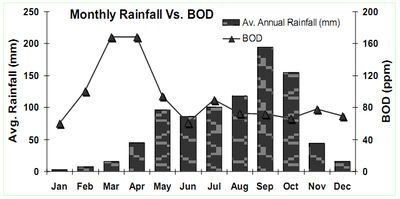
Figure: 6. Relation between the precipitation and mean BOD values
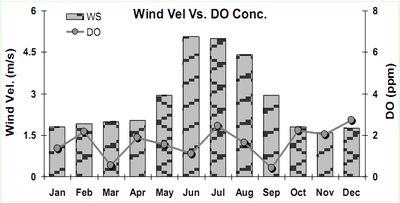
Figure: 7. Relation between the monthly wind velocities with avg. monthly DO level
5. Macrophyte spread and DO levels
Dense macrophyte mats limit re-aeration by isolating the air/water interface [24] and block sunlight, limiting photosynthetic oxygen production. The concentration of DO in the lakes diminish as a result of biodegradation of carbonaceous and nitrogenous wastes discharged into the waterbodies, deposited in the sediment and the influx of plant limiting nutrients which leads to eutrophication. [25]. In addition, the large organic load created by water hyacinth mats and other vegetation associated with these mats, increase oxygen consumption [26, 27], and they act as a physical substrate for microbes, the metabolic activity of which further increases oxygen demand [26, 24, 9]. Additionally, the extent of water hyacinth infestation within the lagoons may modify edge roughness, water depth and current velocity allowing flowing water to pass through the middle layers of the water column thus reducing the detention time and greatly inhibiting mixing and re-aeration within the lake [26, 28]. In tropical semi-arid zone lakes, there are also substantial variations in DO between different periods of a day where occasional low DO levels can result in the elimination of key aquatic species. In the case of eutrophic lakes though the DO levels become supersaturated at the mid-day, there are chances of DO reaching 0 ppm due to respiration at night when the concentration of algal biomass is very high and bacteria as well as aquatic biota compete for oxygen resulting in anoxia at night.
During summer around 85% of the exposed water surface area is packed with macrophytes. Total N trapped in the biomass accounts to 1.8 ktons (for a macrophyte cover of 85% in a water spread area of 220 hectares) as water hyacinth can store 1 kg/m2. Significant diurnal (January and April 2009) variations of DO levels in water were observed to be influenced by the macrophytes in the lake [Figure-8; Figure-9]. Figure 8 shows DO measured at the south outlet when it is free of water hyacinth, while the Figure 9. shows lower DO values measured near the macrophyte infested area which represents restriction of algal growth and algae driven photosynthesis. There was no improvement in the DO levels of the north outlet because of persistent stagnation and the presence of floating macrophytes. As the water flow passes the macrophytes, it undergoes an anaerobic phase, thereby bringing down the DO levels to zero. Figure: 9. gives a comparison between the inlet and outlet DO concentrations, during the dense macrophyte cover.
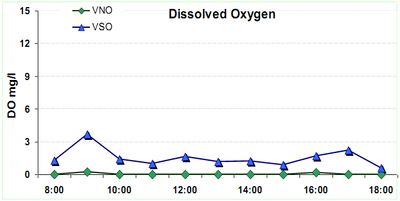
Figure: 8. Diurnal changes of DO levels during April 2009 (summer) at north outlets.
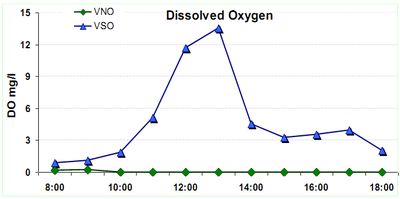
Figure: 9. Diurnal variations in DO concentrations at inlet and outlets
Upstream conditions greatly influences the downstream DO. Improvement in the oxygen content in the Varthur lake outlets shows increasing DO levels with flow. When water is released into storm water drains, its oxygen level is high. However, the oxygen content rapidly diminishes as water move downstream due to mixing of fresh sewage and prevailing anoxic conditions with high organic load and infestation of weeds. This necessitates the clearance of the macrophytes/weeds. Macrophyte removal in the upstream and increasing DO levels at earlier stages would improve the quality of water discharged and that accumulating in the downstream lakes.
6. Modified flows, nutrients, proliferation of water hyacinth and rapid nutrient uptake
There is a dynamic interaction between flow, habitat condition and DO saturation in these lakes. Almost all lakes in Bangalore region receive a continuous supplemental dry season flow from sewage or the adjacent agricultural fields. Although the nutrient concentration in the water of Varthur lake was more or less similar with respect to nitrates but an increase in phosphate concentration was observed in summer which correlates positively with the growth of macrophytes and conducive environments for the release of nutrients trapped in the sediments.
The bulk of nutrient uptake during the summer season is performed by the widespread free floating macrophytes. These macrophytes which mainly comprises of water hyacinth and Alternanthera sp.covering a substantial portion of the lake surface (85%) as depicted in the earlier figure it captures about 4.5 tons of N/day. They propagate very fast with a very high growth rate and engulf the entire water surface in about three months.
The nutrient (C and N) content of the dominant macrophyte population in the lake (from left to right) was investigated. In the lake 10 macrophyte species were observed out of which five dominant macrophyte species arranged as per their abundance from left to right are plotted against their % N content [Figure-10]. Higher N content were observed in case of Lemna gibba and Alternanathera phyloxiroides ~ 4 g/100 d of dry wt., followed by water hyacinth (2.3 g/100 d of dry wt), Typha augustifolia (1.5 g/100 d of dry wt) and Cyperus sp.( 1.2 g/100 d of dry wt). In other studies The highest N content was found in Potamogeton trichoidesCham.(2.33 g/100 g dry wt.) and Baldellia ranunculoides (L.) Parl (2.26 g/100 g dry wt.)[29]. The study conducted in an agricultural drainage lake showed an N content of 2.65 g N /100 g dry wt. in Potamogeton nodosus Poir [30]. The N content in Lemna gibba in treating the domestic primary effluent in Israel was recorded to be 4.3 % dry wt. which is comparable with the present studies [31]. The study on growth and nutrient storage of water hyacinth showed that 1.6 g N/ 100 g of dry wt was stored under condition of higher productivity [32].
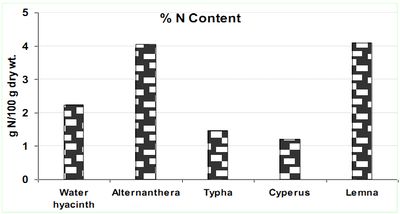
Figure: 10. Variations in per cent N content among the dominant macrophytes from left to right.
The study shows that Alternanthera sp. together with water hyacinth would have been a dominant accumulator of nutrient in NH4-N forms. However there was no significant variation in the C content [Figure-11] among the major macrophyte species.

Figure: 11. Variations in % C Content among the dominant macrophyte species.
7. Plans for the management of macrophytes and associated lower levels of DO
Management arrangements need to recognize that when macrophyte infestations cover the surface of the lagoons, the quality of the aquatic habitat provided is very poor, and opportunities to provide healthy aquatic habitat in a region where most of the existing urban wetlands have been lost or seriously degraded, should be utilized. It is suggested that harvesting and removal of aquatic weeds from the lake rather than letting them sink to the bottom is a necessary prophylactic need. However, due to the large water hyacinth biomass and associated weeds, it was felt that their decomposition process (involving bacteria) would have resulted in significant consumption of the limited DO. Unmanaged exotic aquatic weeds consistently results in poor water quality and reduces the economic value of these otherwise productive habitats. Although the lake examined in this study is impacted by many factors such as altered hydrological regime, increased turbidity and nutrient loads, loss of their riparian zone and run-off from surrounding agricultural areas, the wind induced compaction and removal of macrophytes showed an immediate and substantial improvement in DO levels which were previously excluded because of the low DO content created by weed infestations.
Given the importance of these urban lakes in terms of their role in the livelihood of poor farmers, hydrological cycling, maintenance of micro-climate, as a sink to enormous pollutants and of their high recreational and commercial values there is an immediate need for a rapid improvement of the health of the system which would benefit to maintain the aquatic ecological integrity with optimal balance in urban aquatic systems. The lakes would be very essential further down the years looking at the serious crisis of water, and needs to be well managed for its sustainable functioning and reuse.
Findings of the study show waterbodies further being degraded by the spread and cover of the aquatic weeds/macrophytes and presses on the issues related to complete breakdown of the urban aquatic systems. The results of this study paves a way for initiation and implementation of aquatic weed control programs under existing Urban infrastructure planning and management. |











